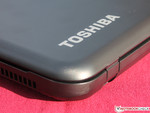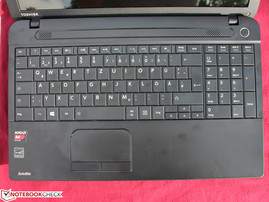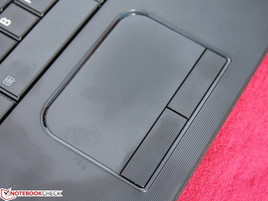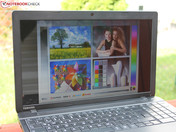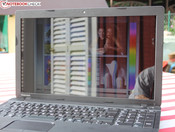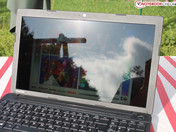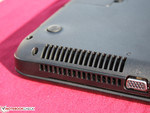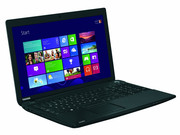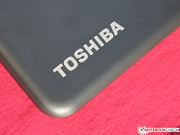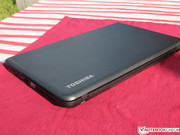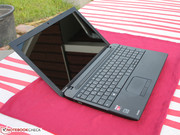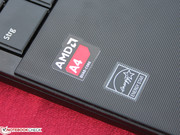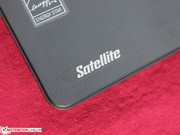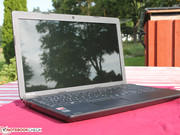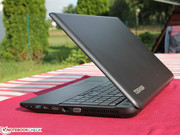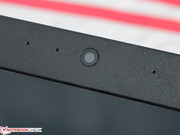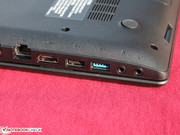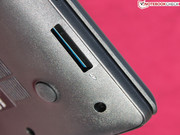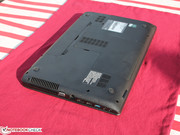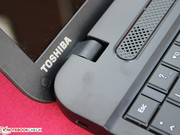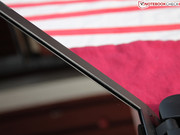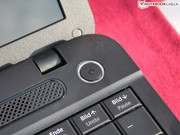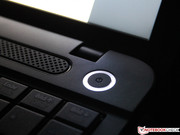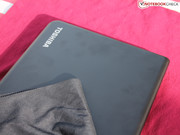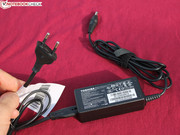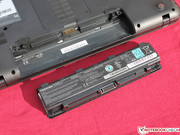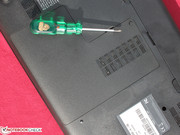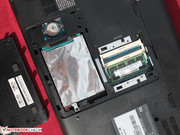Review Toshiba Satellite C50D-A-10E Notebook

For the original German review, see here.
Those who were looking for a laptop priced between 250 and 400 Euros (~$330 and $528) must have seen a lot of AMD configurations with a Trinity A4 APU in the last few years. Unfortunately, we were never wooed by the performance of its two Piledriver cores. Even when it was bundled with a powerful dedicated graphics card, the sluggish CPU often manages to slow games down (at least from medium settings onwards). Moreover, systems with an integrated GPU tended not even to manage smooth frame rates with the lowest possible settings.
Pure performance was much worse than that of Intel's Pentium or Celeron CPUs (dual-core) which is why we rarely found good reasons for preferring a Trinity-based system. But may this be different with a quad-core Kabini APU? Our short review: AMD A4-5000 APU "Kabini" (May 2013) already showed noticeable improvements in performance. So is this quad-core the right choice for a mainstream office and multimedia laptop? Which features did Toshiba choose to include in order to deliver a usable device with an aggressive price point of around 400 Euros ($528)? We will try to find the answers to these questions in the sections below.
The Toshiba Satellite C50D can be compared to the Lenovo G500s (Pentium 2020M, Intel HD) and the Lenovo G505s-20255 (HD 8570M dual graphics, A6-5350M), both of which sport a plastic chassis as well. These competitors allow us to confront the Kabini platform with Intel's Pentium and Core i3 chips.
In order to be able to offer a competitive price, Toshiba uses matte plastic. The stability of the base unit is mediocre, but still okay (except when pressure is applied near the optical drive, something that worsens the overall impression when it is lifted up). The lid, however, can be bent and twisted like crazy. It is also very pressure-sensitive, especially so in its lower half. There are some noticeable clearances between the display and its frame. In addition, the display hinges wobble when they reach their maximum opening angle of approximately 135 degrees.
When opening the device, the hinges offer a lot of resistance so that both hands are required. Unfortunately, there is no clutch so that we have to pry it open with our fingers wedged between the lid and the base.
The palm rest comes with a slightly rippled surface (the same as on the lid). Still, this does not help against all fingerprints. We were quite satisfied with the stability of the keyboard area as well as the palm rest area. Both remain firmly in place even during typing. Only the left half of the smallish touchpad can be dented when pressure is applied.
The C50D does not sport a lot of ports. Next to VGA, HDMI and the Ethernet port, there is only one USB 3.0 port. Unfortunately, most of these ports are close to the front of the laptop, meaning that their associated cables might get in the way of the mouse. The card reader is located at the front. In order to use it, the laptop has to be lifted up.
Communication
The RJ45 port does not come with a Gigabit connection (1000 Mbit/s), only shipping with a Fast Ethernet variant (Atheros AR8172/8176/8178 PCI-E) which may be a hindrance when trying to transfer numerous files between the laptop and another device (not even putting a Gigabit switch to full use). We are baffled by Toshiba's decision as even the most low-cost laptops come with Gigabit Ethernet these days.
The wireless modem is another low-cost solution: Realtek's RTL8188E Wireless LAN 802.11n only supports the 2.4 GHz band. With such a single-band card, the 5 GHz band cannot be used whenever the 2.4 GHz is blocked. That being said, we were quite surprised by how well the wireless worked. Even when we put 40 meters (~131 feet) between us and the router (no direct line of sight, outside of the building, signal strength of the Fritz!Box 7270 set to 50% as always), we were still measuring four bars of Wi-Fi signal strength. This is even more than what we measured for high-end cards such as the Intel Centrino Advanced-N 6205 (Fujitsu LifeBook P702: two bars at a distance of 40 meters). Most laptops do not even manage to remain connected at such a distance.
Webcam
Colors are vivid, but videos and photos are full of noise, especially close to the corners.
Accessories
The C50D ships with a small power adapter (45 Watts), the battery (which can be plugged in at the underside of the laptop) and a quick start guide with a warranty brochure and safety information. As is the case with most manufacturers, no Windows 8 recovery DVD is included. Fortunately, this can (and should) be remedied by burning a recovery DVD via the Recovery Media Creator.
Not much soft- and bloatware comes preinstalled: McAfee Internet Security (30-day trial version), the new Microsoft Office 365 (1-month trial version) and a number of tools such as Toshiba Desktop Assist.
Maintenance
Since it is necessary to clean a laptop's fans from time to time - unless one is okay with diminishing potential for heat dissipation due to dusty radiators, we were hoping that access to these could be gained by removing the maintenance hatch which is fastened by just one screw. Unfortunately, only the hard drive and the RAM module can be accessed without much more hassle. Possible replacements are 7 mm or 9 mm 2.5-inch SATA HDDs and SSDs (after the main partition has been mirrored) and a second RAM module for the unused bank (1 x 4 GB so far).
Warranty
The Satellite ships with 12 months of warranty (and a pickup-and-return service in Germany). Warranty extensions to up to three or even four years can be had for approximately 100 and 150 Euros (~$132 and $198), respectively.
Keyboard
Keystrokes feel precise, if somewhat dampened. The entire keyboard feels sturdy, with nothing giving in. Toshiba has decided against using a Chiclet design with some space in between the keys (which it employs in the Satellite S50-A and many mid-tier or high-end models). Instead, the keys are tightly spaced without any separation, being just a millimeter apart from each other. Still, this does not pose any problems while typing as each key comes with a raised platform on top of its base.
We are quite fond of the precise pressure point. In addition, the keys offer sufficient travel. Unfortunately, there is no inner curvature that would help in guiding the fingers toward the right keys. Still, despite the fact that the entire keyboard feels a bit like one large surface area, we managed to type with our usual speed and without hitting many wrong keys. Those who work with MS Office a lot might actually be very happy with this keyboard, especially since there is also a dedicated number pad.
Touchpad
The smallish touchpad only sports a diagonal of 9.2 centimeters (~3.6 inches), less than what most of its competitors offer (some 15.6-inch devices come with a 12.5-cm (~4.9 inches) touchpad). The plastic surface is rough to the touch. According to our own experience, these plastic touchpads see some abrasion over time, resulting in ugly "brightly polished stripes".
Thanks to their surface material, the buttons do not feel slippery at all. Still, we cannot recommend them due to short travel and a lot of pressure being necessary to trigger them. The Alps Pointing Device does not support multi-touch gestures - the only exception being two-finger scrolling. Nothing can be configured in the driver settings.
The resolution of 1366x768 pixels is typical for a 15.6-inch laptop in this price segment. This not only leads to a coarse pixel density of 100 dpi (which renders the individual pixels clearly visible), but it also goes hand in hand with a highly reflective TN panel which does not get any brighter than 227 cd/m² in the center. However, most direct competitors offer the same characteristics (reflective, HD panel).
The contrast ratio of 688:1 is actually quite decent, and far ahead of most entry-level displays (usually 200-400:1). Still, the true high-contrast contingent only begins beyond 800-1300:1. Colors look vivid and crisp on the glossy panel.
| |||||||||||||||||||||||||
Brightness Distribution: 78 %
Center on Battery: 227 cd/m²
Contrast: 688:1 (Black: 0.33 cd/m²)
ΔE ColorChecker Calman: 7.5 | ∀{0.5-29.43 Ø4.82}
ΔE Greyscale Calman: 9.12 | ∀{0.09-98 Ø5.1}
49% AdobeRGB 1998 (Argyll 1.6.3 3D)
52.7% AdobeRGB 1998 (Argyll 3D)
72.5% sRGB (Argyll 3D)
52.1% Display P3 (Argyll 3D)
Gamma: 2.16
CCT: 10774 K
Color space and display calibration are only relevant for professional users (image editing, print...) and not so much for the target audience of the Toshiba C50D. Unsurprisingly, both the sRGB color space (72%) and the AdobeRGB (49%) are not covered.
Prior to calibration, we have performed a color analysis with the i1 Pro 2 photo spectrometer. The resulting CalMAN screenshots reveal a weakness in grayscale rendition as well as a strong bluish tint with an average DeltaE (2000) of 9, leading to cooler-than-life colors.
Color saturation measurements show that magenta, cyan and even red are somewhat bluish with high DeltaE (2000) values of around 10 (which means that these distortions can be seen with the naked eye whenever a reference point is available). A calibration can help in mitigating this problem.
No glossy display has it easy during outdoor usage, and the one in the C50D doubly so due to its low peak brightness (227 cd/m² in the center, no matter whether it is running on battery or not). Especially glances from the side are almost impossible. During frontal usage or usage in the shade, reading the display becomes possible. Still, the hassle of finding the right spot remains.
The AMD A4-5000 is a low voltage APU (TDP of 15 Watts) intended for use in subnotebooks and laptops, quickly becoming AMD's new mainstream model for entry-level devices, placing itself above the A6 and below the A8/A10. In parallelized applications, the APU is actually capable of getting close to a low voltage Sandy Bridge Core i3. It comes with an integrated Radeon HD 8330. In addition, there is a 500 GB HDD made by Toshiba and 4 GB of RAM (with the controller being located on the SoC itself, being embedded in the APU).
Processor
AMD's quad-core SoC A4-5000 (1.5 GHz, no turbo) aka Kabini inherits the position of the old Bobcat models (E-350, E2-1800...). The A4-5000 is actually already the fastest of the bunch since the E series APUs E1-2100 to E2-3000 (two cores) are based on the Jaguar architecture.
So how does it fare in terms of computing power when compared to a number of older and recent Intel and AMD CPUs? Despite the Pentium coming with just two cores, it appears to have a clear edge of 30% during multi-core computations (with +156% during single-core tests) according to Cinebench R11.5. Still, the 2020M is a 35-Watt CPU fighting against a 15-Watt model. When compared to a low voltage Core i3 (Toshiba Satellite L830, Sandy Bridge), Kabini actually takes the lead (-10%).
Why are we comparing a standard CPU with a low voltage CPU? Simply because the A4-5000 is used by Toshiba to power a simple 15-inch office laptop which usually sport a 35-Watt Pentium or Celeron CPU.
Compared to other AMD chips, specifically the E2-1800, Kabini takes the lead both during the single threading tests (-15%) and even more so while multithreading (-57%). Similar results hold true in the case of the A6-4455M dual-core (Temash predecessor). Overall, performance levels are quite decent considering that this is a low-voltage model. For more details about its exact performance and its capabilities, have a look at our short review: AMD A4-5000 APU "Kabini".
We do not even have to look closely at its clock speed, since there is no turbo mode in the A4-5000. It is always clocked at 1.5 GHz, no matter whether the laptop is idle or under full load. Even while running on battery, the Cinebench R11.5 CPU and GPU benchmark results remain completely unchanged.
System Performance
The application performance, as measured with PCMark 7 and PCMark Vantage, suffers from the lack of an SSD (or at least a performance-boosting SSD cache). But the C50D's direct competitors cannot afford to include an SSD either while still maintaining an impressive edge over Toshiba's Satellite: Both the Asus VivoBook S300CA (+53%) and the Lenovo G500s (+65%) fare much better in PCMark 7, mostly due to their impressive computation scores (Asus +208%, Lenovo +112%).
PCMark does honor AMD's new quad-core, yielding +34% when compared to the Samsung Series 3 355E5C and +34% when compared to the A4-4300 (Trinity dual-core, Sleekbook TouchSmart 15, +30% at the computation and productivity sub scores). Nominally, a lot has been gained in terms of performance (especially in comparison to its predecessor, the E2-1800), but still, simple Pentium (standard voltage) or Core i3 (low voltage) systems still seem to have the overall edge. Talking specifically about the Satellite C50D, this was not a problem. Everything felt snappy, apps opened fast and rendered smoothly. Those who would not describe themselves as power users or gamers should be satisfied with this kind of performance.
| PCMark Vantage Result | 3178 points | |
| PCMark 7 Score | 1417 points | |
Help | ||
Storage Devices
The 2.5-inch Toshiba HDD (MQ01ABF050, 9.5 mm high, 500 GB, 5400 rpm) remains rather silent, but then again, access times of 17.9 ms and sequential read values of 83 to 95 MB/s (even worse for small, scattered files, with 0.433 MB/s during the 4K test) are average at best, leading to mediocre HDD scores in all system benchmarks.
Graphics Card
The Radeon HD 8330 comes with two Compute Units clocked at 500 MHz (no turbo) which only support single-channel RAM. The GPU is very capable of Full HD video playback, supporting the CPU via the hardware-based Video Decoder. Its pure performance levels (OpenGL 64-bit) have been improved by +19% when compared to its predecessor (E2-1800, Series 3 355E5C), but it does not manage to take the lead when compared to the HD 7400G in the A4-4355M. The HD 8330 does, however, beat the HD Graphics of the Pentium 2020M (-23%), being on par with the HD 4000 (Ivy Bridge) GPU.
The gaming benchmarks (standard graphics score during the Ice Storm, Fire Strike and Cloud Gate benchmarks remain on par) agree with these assessments, with the overall standard scores seeing an increase of +25% due to the improved multi-core performance of the quad-core when compared to the dual-core A4.
In almost all of these disciplines, the HD 4000 (Ivy Bridge) takes the top spot (by 20 to 25%). Only during the Ice Storm benchmark does the Asus VivoBook S300CA fall behind the C50D by approximately 8%. The Pentium-based system (Lenovo G500s) falls slightly behind by -3% to -17%. But is this difference actually noticeable in real games?
| 3DMark 06 Standard Score | 2942 points | |
| 3DMark Vantage P Result | 1693 points | |
| 3DMark Ice Storm Standard Score | 25710 points | |
| 3DMark Cloud Gate Standard Score | 2153 points | |
| 3DMark Fire Strike Score | 321 points | |
Help | ||
Gaming Performance
As mentioned above, the gaming performance of the HD 8330 is so low that it does not really make a difference whether one uses a Pentium 2020M, an E2-1800 or an A4-5000. Testing this hypothesis with a number of older, less demanding games has shown a slight edge for AMD's new APU (2020M -14%, E2-1800 -12%), while falling behind the integrated Radeon HD 7400G (+12%) and the HD 4000 (+7%). This means that games can only be played in low resolutions with low details (no anti-aliasing, DX 11). Those who wish to play on their laptop while not exceeding a budget of 400 to 500 Euros (~$528 to $660) should look for one of the many budget laptops with a GT 720M or an HD 8550M.
| Toshiba Satellite C50D-A-10E Radeon HD 8330, A4-5000, Toshiba MQ01ABF050 | HP Pavilion Sleekbook TouchSmart 15-b153sg Radeon HD 7400G, A4-4355M, Hitachi Travelstar Z5K500 HTS545050A7E380 | Asus VivoBook S300CA HD Graphics 4000, 3217U, Hitachi Travelstar Z5K500 HTS545050A7E380 | Lenovo ThinkPad Edge E135 NZV5YGE Radeon HD 7340, E2-1800, Hitachi Travelstar Z7K500 HTS725050A7E630 | Medion Akoya E7221-MD98297 HD Graphics (Ivy Bridge), 2020M, Seagate Momentus SpinPoint M8 ST1000LM024 HN-M101MBB | |
|---|---|---|---|---|---|
| Dead Space 3 | |||||
| 1024x768 Low Preset | 44 | 43 -2% | 37.3 -15% | 42 -5% | |
| Fifa 13 | |||||
| 1366x768 High AA:2xMS | 37 | 22 -41% | 29 -22% | ||
| Diablo III | |||||
| 1024x768 Low / off | 29 | 34 17% | 39.6 37% | ||
| Anno 2070 | |||||
| 1024x768 Low Preset | 33 | 33 0% | 32.4 -2% | 29 -12% | |
| StarCraft 2 | |||||
| 1024x768 low | 51 | 96 88% | |||
| Mass Effect 3 | |||||
| 1280x720 all off | 18 | 14.8 | |||
| Total Average (Program / Settings) | 12% /
12% | 7% /
7% | -12% /
-12% | -14% /
-14% |
| low | med. | high | ultra | |
|---|---|---|---|---|
| StarCraft 2 (2010) | 51 | 24 | 19 | |
| Anno 2070 (2011) | 33 | 15 | 10 | |
| Diablo III (2012) | 29 | 19 | 15 | |
| Fifa 13 (2012) | 91 | 52 | 37 | |
| Dead Space 3 (2013) | 44 | 16 | 12 |
System Noise
The fan is almost always audible and will only deactivate for brief stretches of time if ambient conditions are cool enough, but it could be a lot worse. 31.5 dB(A) while idle will in most cases be blocked out by ambient noise.
The fan rotates slowly, making it very well suited for office usage with its long idle phases. The hard drive remains equally quiet with around 31.5 dB(A), so that we can barely make it out when the fan is active.
During our combined CPU and GPU stress test, the Toshiba Satellite gets as loud as 36 dB(A). While playing games or using 3DMark 2006, 33.5 dB(A) are reached. In both cases, the cooling system is always active without slowing down or spinning up. All of these values are quite decent, but then again, this is what we have expected to see in the case of such a low-power laptop.
Noise Level
| Idle |
| 31.3 / 31.3 / 31.6 dB(A) |
| HDD |
| 31.5 dB(A) |
| DVD |
| 36.3 / dB(A) |
| Load |
| 33.5 / 35.9 dB(A) |
 | ||
30 dB silent 40 dB(A) audible 50 dB(A) loud |
||
min: | ||
Temperature

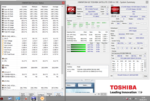
While idle, the laptop barely exceeds 28 degrees Celsius (82.4 Fahrenheit, both on top and beneath the base unit), thanks to the combination of a low voltage CPU and an always-on fan system. Under continuous full load (combined CPU and GPU stress test), nothing much changes. Occasionally, up to 32 or 34 degrees (89.6 or 93.2 Fahrenheit) are reached; with an average value just 2 degrees above that while the laptop is idle.
During the stress test, the CPU is constantly clocked at 1.5 GHz (no turbo), with a moderate maximum temperature of just 61 degrees Celsius (141.8 Fahrenheit). The GPU remains at its maximum clock speed of 496 MHz (no turbo either). Thus, throttling is no issue for the AMD APU, allowing both the CPU and the GPU to access their full performance.
(+) The maximum temperature on the upper side is 31.6 °C / 89 F, compared to the average of 34.3 °C / 94 F, ranging from 21.2 to 62.5 °C for the class Office.
(+) The bottom heats up to a maximum of 33.8 °C / 93 F, compared to the average of 36.8 °C / 98 F
(+) In idle usage, the average temperature for the upper side is 28 °C / 82 F, compared to the device average of 29.5 °C / 85 F.
(+) The palmrests and touchpad are cooler than skin temperature with a maximum of 31 °C / 87.8 F and are therefore cool to the touch.
(-) The average temperature of the palmrest area of similar devices was 27.6 °C / 81.7 F (-3.4 °C / -6.1 F).
Speakers
The C50D comes with stereo speakers positioned above the keyboard. They are incapable of getting loud, being dominated by their highs and sounding tinny instead (especially when trying to be loud). Music just sounds plain thin, leading to a very disappointing performance (even for a low-end office laptop).
Power Consumption
Since the APU is no high-performer, does this at least lead to low levels of power consumption? It does. We measure no more than 5 to 11 Watts (Intel: 6 to 11 Watts) while idle and 18 to 23 Watts (plus charging, if necessary) under full load. Intel-based laptops such as the Lenovo G500s require 31 to 37 Watts under full load - which should not come as a surprise, given that it uses a Pentium 2020M with a TDP of 35 Watts instead of the 15 Watts of our test system. The C50D takes the lead in almost all power consumption measurements. Thus, the power adapter (45 Watts) almost feels oversized, but this does of course help in recharging more quickly.
| Off / Standby | |
| Idle | |
| Load |
|
Key:
min: | |
| Toshiba Satellite C50D-A-10E Radeon HD 8330, A4-5000, Toshiba MQ01ABF050 | Samsung Serie 3 355E5C-S02DE Radeon HD 7470M, E2-1800, Hitachi Travelstar 5K750 HTS547575A9E384 | Lenovo G500s-59367693 HD Graphics (Ivy Bridge), 2020M, Seagate Momentus Thin ST500LT0 12-9WS142 | Asus VivoBook S300CA HD Graphics 4000, 3217U, Hitachi Travelstar Z5K500 HTS545050A7E380 | HP Pavilion Sleekbook TouchSmart 15-b153sg Radeon HD 7400G, A4-4355M, Hitachi Travelstar Z5K500 HTS545050A7E380 | |
|---|---|---|---|---|---|
| 3DMark 06 | |||||
| 1280x1024 Standard Score AA:0x AF:0x | 2942 | 3537 20% | 2968 1% | 3356 14% | 2931 0% |
| Power Consumption | -79% | -33% | -30% | -23% | |
| Idle Minimum * | 4.9 | 9.7 -98% | 6.3 -29% | 5.9 -20% | 6.9 -41% |
| Idle Average * | 8.4 | 14 -67% | 8.5 -1% | 10 -19% | 9 -7% |
| Idle Maximum * | 10.8 | 15.3 -42% | 10.7 1% | 10.2 6% | 10.1 6% |
| Load Average * | 18.3 | 35.2 -92% | 31.4 -72% | 30.9 -69% | 26.6 -45% |
| Load Maximum * | 22.5 | 43.9 -95% | 37.3 -66% | 33 -47% | 29.3 -30% |
| Total Average (Program / Settings) | -30% /
-62% | -16% /
-28% | -8% /
-23% | -12% /
-20% |
* ... smaller is better
Battery Life
This is where the C50D is truly capable of shining, especially for a 400 Euro (~$528) 15-inch laptop. During our Wi-Fi browsing test (which comes close to real-life usage patterns, with a script opening websites every 40 seconds, some of them with video playback), we measure 7 hours of battery life from the 48 Wh battery when the display is set to its second-brightest value of 143 cd/m² (center).
DVD playback went on for 3:29 hours with maximum display brightness. Great: During the demanding Battery Eater Classic Test, the laptop held its own for 2:41 hours. In contrast, Lenovo's G500S (Pentium 2020M) does not survive for more than 1:09 hours under full load despite its similarly sized 41 Wh battery. During the Wi-Fi test, the G500S yields a battery runtime of just 3:14 hours.
Verdict
Great battery life, low power consumption, superb ergonomics and a usable keyboard. These are the major strengths of the Toshiba Satellite C50D-A-10E - but unfortunately, they also equate to the only strengths of this 400 Euro (~$528) laptop.
The performance of the quad-core APU is rather decent when compared to Intel's Pentium (standard voltage) or older (Sandy Bridge) Core i3 systems, especially so during parallelized applications. Unfortunately, our system benchmark results did not agree, being crushed by those of their Intel competitors. Games will only barely be playable, no matter how many cores AMD uses.
The display comes with mediocre viewing angles at best. Its build quality is unsatisfactory, the entire device, being made from plastic, does not feel sturdy at all. Then again, performance geeks will never be happy with a device at this price point and other manufacturers struggle as well to use a decent display panel (most come with a more or less strong bluish tint, as does the Satellite C50D). Although Toshiba's laptop does have its strengths - as mentioned above - there are a number of compromises to be accepted: Many similar-priced laptops come with (slightly) better build quality, (slightly) better speakers, better touchpads and with Gigabit Ethernet.
One minor issue we had with our test device: From time to time, the display did not wake up from standby, even though the laptop was running (fans and HDD were active). Whether hitting any key, closing it and opening it again or pressing the power button, none did any good necessitating a hard reboot by pressing the power button for a long time. At least, this error could not be reproduced so that we do not expect this to be an issue for all C50D devices.
Those who mostly work inside while looking for a very quiet laptop that lasts almost a whole day on a charge (or does not consume much power when plugged in) might be happy with the Satellite C50D-A-10E. Browsing the web, using MS Office - the basics work out well. Those who are in need of better performance might want to look elsewhere. Laptops with a standard voltage Core i3 CPU do not cost much more. Lenovo's G500s with a Core i3 2348M and a 500 GB HDD (59372562) can be had for approximately 440 Euros (~$580), barely more than what the Pentium version costs.





